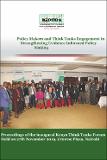Policy Brief No. 14 of 2006 on Policy Options for Financing Secondary Education in Kenya
Publication Date
2006Author
Type
KIPPRA Publicationsviews
downloads
Metadata
Show full item recordBy
The Kenya Institute for Public Policy Research and Analysis
Abstract/
Secondary education is important in generating opportunities for social and economic development. Besides being a transitional level between primary and tertiary education, secondary schooling provides a base for acquiring insights, skills and competences required at the higher levels of education and in the labour market. However, Kenya has low secondary school participation rates. Net enrolment rate is estimated at 17 percent and transition rate from primary to secondary school level at 52 percent in 2004. In year 2004, Kenya had 4,042 secondary schools (12% of them private) with an enrolment of 923,000 students (8% enrolled in private schools) compared to the secondary school age population of 3 million youth.
Subject/
Education sector; Secondary education; Resource limitations; Resource utilization; Education financing
Publisher
The Kenya Institute for Public Policy Research and AnalysisSeries
PB/14/2006;Collections
- Policy Briefs [161]
Related items
Showing items related by title, author, creator and subject.
-
Eradicating Extreem Poverty in West Pokot by 2025: policy Priorities And lessons From the Development of Kenya's First County Poverty Graduation Policy in West Pokot
County Government of West Pokot (County Government of West Pokot, 2020)This paper reflects on what was achieved in 2020 since the West Pokot County Government, and partners embarked on a journey to scale up poverty graduation resulting in an approved county poverty graduation policy and maps ... -
Policy Paper No. 06 of 2020 on Guidelines for Public Policy Development and Review
Moyi, Eliud (The Kenya Institute for Public Policy Research and Analysis (KIPPRA), 2020)KIPPRA’s overall mandate is to provide quality public policy advice to the Government of Kenya and other stakeholders and improve public policy making for the realization of national development goals. KIPPRA does this ... -
Conference Proceedings on Policy Makers and Think Tanks Engagement in Strengthening Evidence Informed Policy Making
Kenya Institute for Public Policy Research and Analysis (KIPPRA) (Kenya Institute for Public Policy Research and Analysis, 2022)The theme of this symposium, “Policy Makers and Think Tanks Engagement for Evidence Informed Decision Making” is very timely since it is a step towards establishing a platform for exchange of views on development and policy ...




